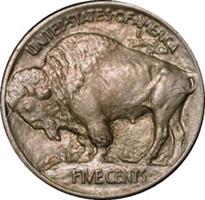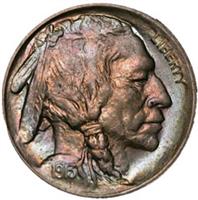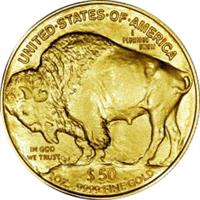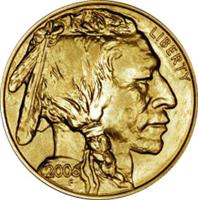24-karat American Buffalo
| Thursday, June 22, 2006 |
| $50 |
| 300,000 |
| 1.287 in (32.7 mm) |
| .116 in (2.946 mm) |
| 1 Troy Oz. |
| Gold 999.9/1000 (24K) Proof |
| $800 |
The United States Mint unveiled its 24-karat American Buffalo gold coins on June 20, 2006.
The American Buffalo gold bullion coins are struck at the Mint's facility at West Point and have the distinction of
being the first pure gold (.9999 fine, 24-karat gold) coins ever struck by the U.S. Mint for public sale as
an investment product. Production of these coins was authorized by the Presidential $1 Coin Act (Public Law
109-145, dated December 22, 2005) and provides for gold bullion to be minted in the form of $50 legal tender
coins, conveying that the content and purity is guaranteed by the United States Government. According to the
official U.S. Mint press release on June 20, 2006:
This American Buffalo Gold Coin will appeal to both investors who choose to hold gold and to
others who simply love gold," said Deputy Director David A. Lebryk during the ceremonial striking at the
United States Mint at West Point, where the coins are being produced. "These classic and beautiful American
Indian and buffalo designs by James Earle Fraser [a student of Augustus Saint-Gaudens], which have been
American favourites since they were first used in 1913, recall a golden age of coin artistry.
Obverse and reverse design
The design of the $50 gold coins is a replica of the popular Buffalo Nickel minted from
1913 to 1938, featuring the image of an American bison one side, and an American Indian on the other. That
coin, known as the Indian Head, was introduced in 1913 and showcases the native beauty of the American West,
with the Native American portrait honoring the legacy of the land's first inhabitants, while the power of the
American Buffalo recalls the pioneering spirit of the Nation's westward expansion. The Fraser "Indian Head"
nickel design was so popular that, prior to its selection as the U.S. Mint's purest gold bullion coin, it was
released by the U.S. Mint as a $1 uncirculated and proof silver coin in 2001.


The Native American depiction on the coin's obverse is believed to be based on three
different Indian chiefs - two of whom were named by the designer as Chief Iron Tail and Chief Two Moons -
who modeled for Fraser as he sculpted its design. Conflicting statements exist on the third Indian as being
either Chief John Big Tree of the Onondaga tribe, or John Two Guns, son of White Calf. It is widely believed
that the bison on the coin's reverse was modeled after "Black Diamond," a popular attraction at the New York
Zoological Gardens. In the first year of the coin's issuance, 1913, there were two distinct varieties, the
first showing the bison on a mound (Type I) and the second with the base redesigned to a thinner, straight
line (Type II). The buffalo without the Indian chief made a brief comeback on the nickel in 2005 as one
of the designs used to commemorate the 200th anniversary of the Lewis and Clark expedition.


The new American Buffalo Gold coin's obverse and reverse designs feature images originally
prepared by the noted American sculptor James Earle Fraser, once a student of Augustus Saint-Gaudens, for
America's 5-cent coin (nickel). The golden buffalo has a buffalo standing on a grassy mound on one side and a
stern-looking Indian chief on the other side (Fraser Type I design), along with the inscriptions of the coin's
weight, denomination and gold content incused on the reverse (Buffalo side). By law, each Buffalo Gold Coin
contains one troy ounce of 24 Karat gold and it is legal tender bearing a $50 face value.
Production details
The U.S. Mint in West Point, N.Y., produced the one-ounce coins in both a bullion
version for investors and a proof version for collectors. Although the face value is $50, the price
depends on the price of gold, plus markups. According to the Mint, it will sell the coins to authorized
purchasers, who will distribute the coins to a network of several thousand dealers - coin shops, banks and
other financial institutions. Those purchasers will be able to sell the pieces to the secondary market. The
final price is based on the current price of gold, plus a premium of about 3% to cover minting and marketing,
while other markups in the distribution chain are expected to push the final sales price to about 5% to 7.5%
above the market gold price.
The United States Mint will also produce a proof version of these coins for collectors. The
title "proof" refers to a specialized minting process that begins by manually feeding burnished coin blanks
into presses fitted with special dies. Each coin is struck multiple times so the softly frosted and highly
detailed images seem to float above the field. An official Certificate of Authenticity will accompany each
coin. The Mint is setting the initial price for the proof coin, which bears the "W" mint mark of the West
Point mint, at $800 and will only produce 300,000 of them, while spot gold was worth about $570 an ounce.
In 2006, only the 1-ounce gold bullion version will be produced, to be followed in 2007 by
half-, quarter-, and tenth-ounce versions. The American gold Eagle program will continue to be struck, as it
has since 1986, in all four sizes of .917 fine gold. Packaging for the new gold Buffaloes will consist of each
coin sealed in a mylar-like plastic sheet, configured 4 rows of 5 coins each. These 20-coin sheets will come
from the Mint in boxes of 500 1-ounce coins per box. Collector s can buy the proof coins from dealers or
directly from the Mint by going to the Mint's website -- or by calling
1-800-USA-Mint.
From 22K to 24K godl coins
The United States Mint is the world's largest maker of 22-karat (91.67 fineness) gold
bullion coins, called the American Eagles, and also silver and platinum American Eagles. However, investors
only had the option of purchasing 22-karat gold when buying American coins, because 24-karat gold is softer
and it was generally accepted that a 24-karat coin would not stand up to the rigors of circulating. Thus,
although gold coins have not circulated since 1933, American gold coins have traditionally been a mix of gold
with copper and silver for hardness. This descision was changed because of stiff competition in the gold
investing world from Canada and others, that forced Congress to authorize the production of the new American
Buffalo coins.
Deputy Director David A.Lebryk estimated that the world market in gold coins is divided
between sales of 24-karat coins such as the Canadian Maple Leaf, which account for 60% of the market, and more
durable 22-karat coins, a category dominated by the American Eagle. Last year the mint sold 420,000 American
Eagle coins, which also have a face value of $50 and contain 1 ounce of gold plus some alloy metal for
durability. The American Buffalo became the first .9999 fine 24-karat gold coin ever struck by the United
States Mint and offered for sale through a network of Authorized Purchasers. They are available to members of
the public seeking a simple and tangible means to own and invest in 24-karat gold in the form of legal tender
coins whose content and purity is guaranteed by the United States Government. The coins are available at many
coin and precious metals dealers as well as many brokerage houses and participating banks. Pricing for precious
metal investment coins typically depends on the market price of the metal.
Officials believe with the new coin they have found a winning combination that will appeal
to nostalgia buffs and investors and hope that the new American Buffalo gold coin will be a hit not only in
this country but with investors around the world. Global investors the past few years have turned increasingly
to purer gold coins. Those sales now make up about 60% of the gold coin market, led by Canada's Maple Leaf.